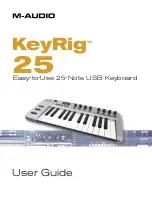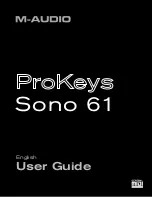
5
7.
Velocity-Sensitive Keyboard:
The velocity-sensitive keyboard is not only the primary method of sending Note
On/Off and velocity data when performing, it is also used to access extended programing functions listed along
its upper edge.
8.
Octave Buttons:
The Octave buttons are used to shift the keyboard’s octave range up or down in one octave
increments, extending the octave range of the pads or keys.
9.
Pitch Bend Wheel:
This wheel creates expressive changes in performances by raising and lowering pitch.
Rolling the Pitch Bend wheel upward will raise an instrument’s pitch whereas rolling it downward will lower the
pitch. The upper and lower pitch bend limit is determined by settings on your hardware or software synthesizer,
not by the Pitch Bend wheel on the Oxygen 49 keyboard itself. Typically, this can be either a half note or an
octave up/down. This wheel is spring mounted and will return to the center detent position when released. The
Pitch Bend wheel is an assignable controller capable of sending a variety of MIDI messages other than pitch
bend data.
10.
Modulation Wheel:
This wheel is used to add expression to performances by changing the intensity of certain
effects. By default, most synthesizers assign this wheel to control vibrato (change in intonation) or tremolo
(change in volume) although it is usually possible to reassign the function of this wheel through the instrument’s
control panel. Rolling the Modulation Wheel upward will increase the modulation effect, while rolling downward
will reduce the
effect. The Modulation Wheel is an assignable controller capable of sending a variety of MIDI
messages other than Modulation data.
11.
Control Buttons:
These
mapable buttons can be assigned to send Note, CC, and other MIDI messages. For
DirectLink operation, please see the DirectLink User Guide Available at
m-audio.com/directlink
.
Rear Panel
1.
USB Port:
The USB 2.0 port (backward-compatible with USB 1.1)
delivers power to the keyboard and transmits MIDI data
when
connected to a computer.
2.
Sustain Pedal Input:
This input accepts a momentary-contact foot
pedal (not included). When pressed, this pedal will sustain the
sound you are playing without having to keep your fingers pressing
down on the keys. The sustain pedal input can be assigned to send Note, CC, and other MIDI messages.
NOTE:
The polarity of the sustain pedal is determined by the keyboard upon startup. When an Oxygen 49
keyboard is powering up, the sustain pedal is assumed to be in the "up" (Off) position. It is important that the
sustain pedal is not pressed during startup, otherwise the pedal will reverse its operation, and notes will sustain
when the pedal is not pressed.
3.
On/Off Switch:
Use this switch to power the device on or off. When this switch is set to the “on” position,
Oxygen 49 is powered through
the USB connection to your computer.
4.
Kensington Lock Connector:
This connector is compatible with standard laptop-style Kensington
security
cables for theft protection.
Advanced Keyboard Functions
Edit Button:
The Edit button is used to access the advanced Oxygen 49 functions located on the keybed. Pressing
the Edit button switches your keyboard into Edit Mode. You can use the keys to select various advanced functions
and enter data.
To change the functionality of a fader, button, knob, etc.:
1.
Press the Edit button.
2.
Press the Select button or Control Select (Ctrl Sel) key.
3.
Move or press the control corresponding to the control you would like to change or using the keys, enter the
numerical value of the control number.
4.
Press the corresponding key of the parameter you would like to change (Ctrl Asgn, Data 1, Data 2, etc.)
5.
Use the numeric keys to enter the value of the parameter.
Snapshot:
Press the Shift button and the Auto button simultaneously to engage the Snapshot function.
The
Snapshot function sends out the assigned MIDI Message and current value of all controls on the MIDI channel that a
control is set to. This feature lets you record current settings of the controls into your sequencer.
DirectLink Mode:
Press the Auto button to go into
DirectLink
Mode. Knobs, buttons, “<” and “>”, and faders will
send pre-programmed automapped messages. None of these parameters can be edited while in
DirectLink
Mode.
For some DAWs and programs, you may need to download DirectLink profiles from
m-audio.com/directlink.
1 2 3
4
1
2
3
4
5
6
7
8
9
10





































